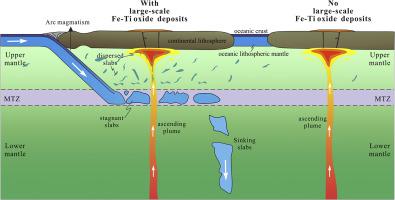Lithos ( IF 3.5 ) Pub Date : 2021-07-10 , DOI: 10.1016/j.lithos.2021.106355 Sheng-Zhu Zhu 1, 2, 3, 4 , Xiao-Long Huang 1, 2, 3 , Fan Yang 1, 2, 3 , Peng-Li He 1, 2, 3

|
The majority of global Fe–Ti-oxide deposits hosted in mafic–ultramafic layered intrusions are closely related to mantle plume activity. The metallogenesis of these Fe–Ti-oxide deposits is still debated, especially with regard to their mantle source and relationship to magmatism. Here we report detailed petrology and geochemistry for early Permian (ca. 280 Ma) mafic–ultramafic igneous rocks in the Wajilitag area of the western Tarim Large Igneous Province (TLIP) to establish the relationships among mantle source, magmatism, and metallogenesis in mantle plume activity. The mafic rocks (i.e., gabbro and diabase) show alkaline affinities and OIB-like trace-element patterns. Clinopyroxenites closely related to Fe–Ti-oxide deposits were derived from the same magmatic system as that of the mafic rocks. The primary magma of the Wajilitag mafic rocks was enriched in FeOT and TiO2 and depleted in SiO2, and has high FC3MS (FeOT/CaO − 3MgO/SiO2) and Fe/Mn, indicating the involvement of Si-poor pyroxenite/eclogite in the mantle source. Primary olivines from the Wajilitag gabbro have consistently high NiO and Fe/Mn. Wajilitag mafic rocks have variable Sr–Nd–Hf isotopes owing to their derivation from a hybrid mantle source with the involvement of subducted oceanic crust and sediments. Subducted slabs within the upper mantle are inferred to have been entrained by the upwelling mantle plume and preferentially melted to produce mainly Fe-rich magma. The occurrence of an adjacent oceanic subduction event just prior to the operation of a mantle plume played a crucial role in the formation of large-scale Fe–Ti-oxide deposits in LIPs.
中文翻译:

塔里木大火成岩省瓦吉里塔格地区早二叠世基性-超基性岩岩石学和地球化学:对地幔柱活动富铁岩浆的洞察
大多数位于镁铁质-超镁铁质层状侵入体中的全球铁-钛氧化物矿床与地幔柱活动密切相关。这些 Fe-Ti 氧化物矿床的成矿作用仍然存在争议,特别是关于它们的地幔来源和与岩浆作用的关系。在这里,我们报告了塔里木大火成岩省(TLIP)西部瓦吉里塔格地区早二叠世(约 280 Ma)基性-超镁铁质火成岩的详细岩石学和地球化学,以建立地幔柱中地幔源、岩浆作用和成矿作用之间的关系活动。镁铁质岩石(即辉长岩和辉绿岩)显示出碱性亲和力和类似 OIB 的微量元素模式。与铁钛氧化物矿床密切相关的单斜辉石岩与基性岩来自相同的岩浆系统。T和 TiO 2且贫 SiO 2,并具有高 FC3MS (FeO T /CaO − 3MgO/SiO 2) 和 Fe/Mn,表明在地幔源中涉及贫硅辉石岩/榴辉岩。瓦吉里塔格辉长岩的原生橄榄石始终具有较高的 NiO 和 Fe/Mn。Wajilitag 基性岩具有可变的 Sr-Nd-Hf 同位素,因为它们源自混合地幔源,并涉及俯冲洋壳和沉积物。据推测,上地幔内的俯冲板块被上涌的地幔柱夹带,并优先熔化以产生主要是富铁的岩浆。就在地幔柱运行之前发生的相邻海洋俯冲事件在 LIP 中大规模 Fe-Ti 氧化物沉积物的形成中起着至关重要的作用。


























 京公网安备 11010802027423号
京公网安备 11010802027423号